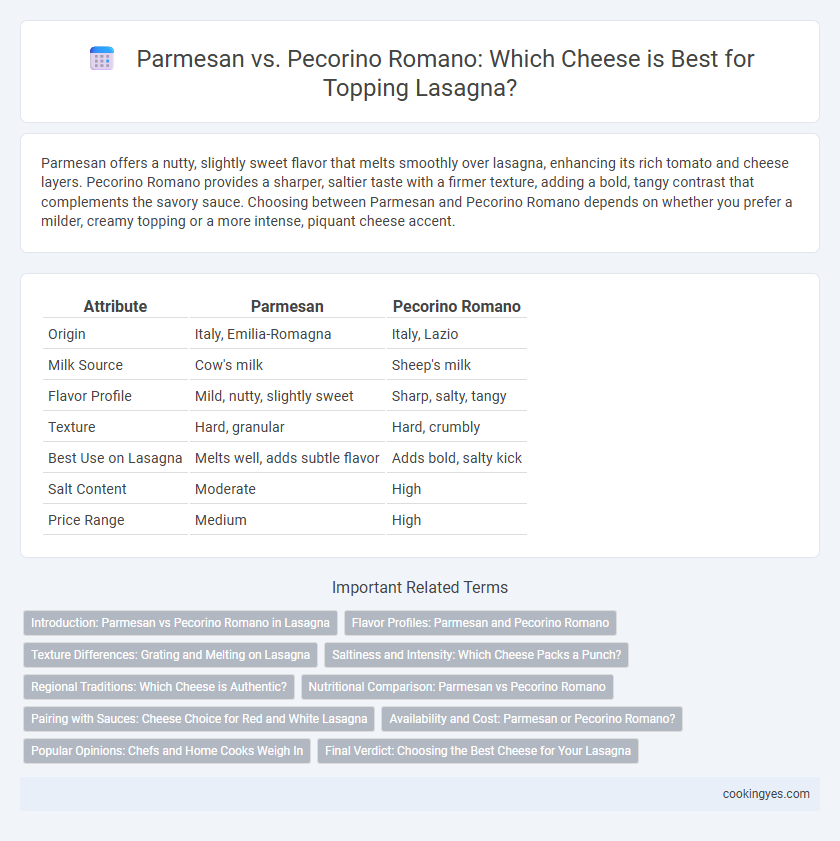Parmesan offers a nutty, slightly sweet flavor that melts smoothly over lasagna, enhancing its rich tomato and cheese layers. Pecorino Romano provides a sharper, saltier taste with a firmer texture, adding a bold, tangy contrast that complements the savory sauce. Choosing between Parmesan and Pecorino Romano depends on whether you prefer a milder, creamy topping or a more intense, piquant cheese accent.
Table of Comparison
| Attribute | Parmesan | Pecorino Romano |
|---|---|---|
| Origin | Italy, Emilia-Romagna | Italy, Lazio |
| Milk Source | Cow's milk | Sheep's milk |
| Flavor Profile | Mild, nutty, slightly sweet | Sharp, salty, tangy |
| Texture | Hard, granular | Hard, crumbly |
| Best Use on Lasagna | Melts well, adds subtle flavor | Adds bold, salty kick |
| Salt Content | Moderate | High |
| Price Range | Medium | High |
Introduction: Parmesan vs Pecorino Romano in Lasagna
Parmesan delivers a nutty, slightly sweet flavor with a granular texture that melts into lasagna layers, enhancing its rich, creamy tomato sauce. Pecorino Romano offers a sharper, saltier taste derived from sheep's milk, adding a tangy intensity that contrasts well with the pasta and cheese blend. Choosing between Parmesan and Pecorino Romano toppling influences the overall flavor profile, balancing between savory depth and bold zest in authentic lasagna recipes.
Flavor Profiles: Parmesan and Pecorino Romano
Parmesan offers a nutty, savory flavor with a slightly granular texture that melts smoothly on lasagna, enhancing its richness without overpowering other ingredients. Pecorino Romano delivers a sharper, saltier taste derived from sheep's milk, adding a bold, tangy punch that intensifies the overall flavor complexity of the dish. Choosing between Parmesan and Pecorino Romano depends on whether a milder, creamy finish or a robust, piquant topping best complements your lasagna's sauce and cheese layers.
Texture Differences: Grating and Melting on Lasagna
Parmesan boasts a granular texture that grates evenly, creating a fine, fluffy topping that melts smoothly and imparts a creamy richness to lasagna. Pecorino Romano, with its harder, more crystalline texture, grates into coarser shards that retain some bite and offer a sharper, saltier finish when melted. Selecting Parmesan enhances a velvety melt, while Pecorino Romano adds distinct texture contrast and a robust flavor profile to the lasagna topping.
Saltiness and Intensity: Which Cheese Packs a Punch?
Parmesan offers a balanced saltiness with a nutty, mildly tangy flavor that enhances lasagna without overpowering other ingredients. Pecorino Romano, made from sheep's milk, delivers a sharper, saltier, and more intense taste, making it ideal for those seeking a bold cheese punch on top of their lasagna. Choosing between Parmesan and Pecorino Romano depends on whether you prefer a subtle savory boost or a strong, assertive saltiness to elevate the dish.
Regional Traditions: Which Cheese is Authentic?
Parmesan, known as Parmigiano-Reggiano, is traditionally used in Northern Italian lasagna recipes, originating from Emilia-Romagna, where its nutty and granular texture complements the rich bechamel and ragu layers. Pecorino Romano, a sharper and saltier sheep's milk cheese, is more commonly associated with Central and Southern Italian dishes, especially in Roman cuisine, but is less typical in classic lasagna preparations. Authentic regional lasagna recipes favor Parmesan for its depth and melting qualities, aligning with Emilia-Romagna's culinary heritage.
Nutritional Comparison: Parmesan vs Pecorino Romano
Parmesan and Pecorino Romano both offer rich flavors for lasagna toppings but differ nutritionally. Parmesan contains less sodium and fat, with approximately 431 calories, 28 grams of protein, and 4 grams of carbohydrates per 100 grams, making it slightly leaner. Pecorino Romano has higher sodium levels and fat content, with about 387 calories, 22 grams of protein, and 3 grams of carbohydrates per 100 grams, contributing to a saltier and sharper taste profile.
Pairing with Sauces: Cheese Choice for Red and White Lasagna
Parmesan's nutty and slightly sweet flavor pairs exceptionally well with rich tomato-based red lasagna sauces, enhancing their savory depth without overwhelming the palate. Pecorino Romano, with its sharp and salty profile, complements buttery and creamy white lasagna sauces, adding a tangy contrast that balances the dish's richness. Choosing Parmesan for red sauces and Pecorino Romano for white sauces optimizes flavor harmony, making each bite perfectly balanced.
Availability and Cost: Parmesan or Pecorino Romano?
Parmesan cheese is more widely available in grocery stores and often comes at a slightly lower cost compared to Pecorino Romano, making it a budget-friendly choice for lasagna toppings. Pecorino Romano, made from sheep's milk, tends to have a sharper flavor and can be pricier due to its specialty nature and limited production regions. Pricing and accessibility considerations often lead home cooks to choose Parmesan for convenience and cost-effectiveness in their lasagna recipes.
Popular Opinions: Chefs and Home Cooks Weigh In
Parmesan is favored by many chefs and home cooks for its nutty, mellow flavor that enhances lasagna without overpowering other ingredients. Pecorino Romano, known for its sharp, salty profile, is preferred by those seeking a bolder taste that cuts through rich sauces and cheeses. Popular opinion often balances Parmesan's subtlety with Pecorino's intensity, with some cooks blending both to achieve a complex, savory topping.
Final Verdict: Choosing the Best Cheese for Your Lasagna
Parmesan offers a nutty, slightly sweet flavor that melts smoothly, enhancing lasagna's creamy layers with a delicate richness. Pecorino Romano delivers a sharper, saltier punch, providing a bold contrast that cuts through the tomato sauce and meatiness. Choosing Parmesan is ideal for a balanced, classic lasagna, while Pecorino Romano suits those seeking a more pronounced, tangy finish.
Parmesan vs Pecorino Romano for topping Infographic

 cookingyes.com
cookingyes.com